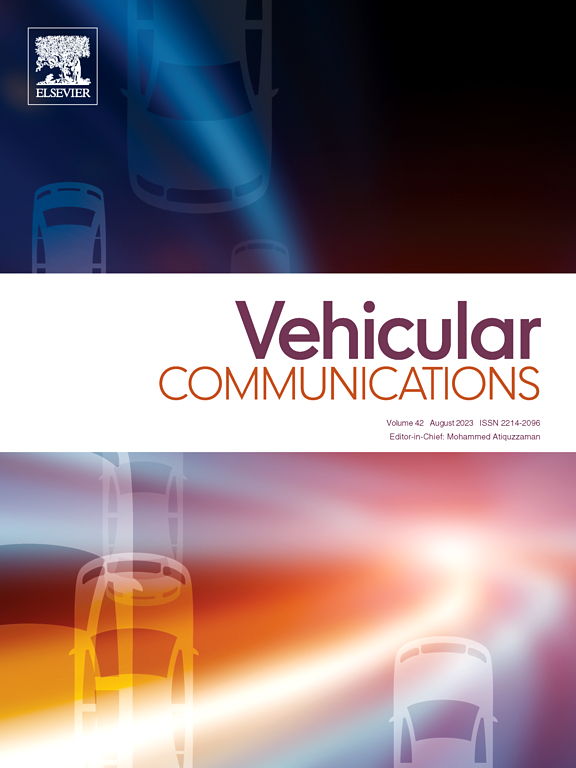Joint edge caching and computation offloading for heterogeneous tasks in MEC-enabled vehicular networks
IF 5.8
2区 计算机科学
Q1 TELECOMMUNICATIONS
引用次数: 0
Abstract
Edge caching is an effective paradigm that can significantly reduce the computation task offloading latency for mobile edge computing (MEC) in vehicular networks, while also alleviating the backhaul transmission pressure for retrieving content data from the cloud server. However, most existing works fail to address how to handle heterogeneous tasks generated by vehicle terminals (VTs), especially in complex scenarios where both computation and content tasks are generated simultaneously. In this paper, we consider a mobility-aware vehicular network model where VTs simultaneously generate heterogeneous task requests, i.e., a computation task and a content task, and investigate joint optimization of caching for heterogeneous tasks data, computation offloading, and computing resource allocation. In order to optimize the latency for processing the heterogeneous tasks, an average execution latency minimization problem with sojourn time and caching capacity constraints is formulated. We decompose this problem into two tractable subproblems, i.e., caching optimization subproblem, and computation offloading and resource allocation optimization subproblem. We first develop a dynamic programming (DP) algorithm to obtain the optimal caching strategies for heterogeneous tasks data. We compare the obtained content retrieval latency with the local computing latency, and derive the optimal computation offloading and edge computing resource allocation solutions. On this basis, we propose a joint computation offloading and resource allocation (JCORA) algorithm to determine the computing resources allocated to each VT and corresponding computation offloading strategy. Numerical results indicate that the proposed algorithm, which integrates DP algorithm and JCORA algorithm, can achieve lower execution latency for heterogeneous tasks compared to the benchmark schemes. Additionally, for task loss scenarios where the sojourn time constraint cannot be met, the impact of VT mobility on the task loss probability is also revealed.
基于mec的车辆网络中异构任务的联合边缘缓存和计算卸载
边缘缓存是一种有效的范例,它可以显著减少车载网络中移动边缘计算(MEC)的计算任务卸载延迟,同时也减轻了从云服务器检索内容数据的回程传输压力。然而,大多数现有的工作未能解决如何处理车载终端(vt)生成的异构任务,特别是在计算任务和内容任务同时生成的复杂场景下。在本文中,我们考虑了一个移动感知的车辆网络模型,其中虚拟车辆同时生成异构任务请求,即计算任务和内容任务,并研究了异构任务数据缓存、计算卸载和计算资源分配的联合优化。为了优化异构任务处理的延迟,提出了一个具有暂居时间和缓存容量约束的平均执行延迟最小化问题。将该问题分解为两个可处理的子问题,即缓存优化子问题和计算卸载与资源分配优化子问题。首先,我们开发了一种动态规划(DP)算法来获得异构任务数据的最优缓存策略。将获得的内容检索延迟与局部计算延迟进行比较,得出最优的计算卸载和边缘计算资源分配方案。在此基础上,提出了一种联合计算卸载和资源分配(JCORA)算法,以确定分配给每个VT的计算资源和相应的计算卸载策略。数值结果表明,该算法结合了DP算法和JCORA算法,与基准方案相比,可以实现更低的异构任务执行时延。此外,对于逗留时间不满足约束的任务丢失场景,还揭示了VT移动性对任务丢失概率的影响。
本文章由计算机程序翻译,如有差异,请以英文原文为准。
求助全文
约1分钟内获得全文
求助全文
来源期刊

Vehicular Communications
Engineering-Electrical and Electronic Engineering
CiteScore
12.70
自引率
10.40%
发文量
88
审稿时长
62 days
期刊介绍:
Vehicular communications is a growing area of communications between vehicles and including roadside communication infrastructure. Advances in wireless communications are making possible sharing of information through real time communications between vehicles and infrastructure. This has led to applications to increase safety of vehicles and communication between passengers and the Internet. Standardization efforts on vehicular communication are also underway to make vehicular transportation safer, greener and easier.
The aim of the journal is to publish high quality peer–reviewed papers in the area of vehicular communications. The scope encompasses all types of communications involving vehicles, including vehicle–to–vehicle and vehicle–to–infrastructure. The scope includes (but not limited to) the following topics related to vehicular communications:
Vehicle to vehicle and vehicle to infrastructure communications
Channel modelling, modulating and coding
Congestion Control and scalability issues
Protocol design, testing and verification
Routing in vehicular networks
Security issues and countermeasures
Deployment and field testing
Reducing energy consumption and enhancing safety of vehicles
Wireless in–car networks
Data collection and dissemination methods
Mobility and handover issues
Safety and driver assistance applications
UAV
Underwater communications
Autonomous cooperative driving
Social networks
Internet of vehicles
Standardization of protocols.
 求助内容:
求助内容: 应助结果提醒方式:
应助结果提醒方式:


